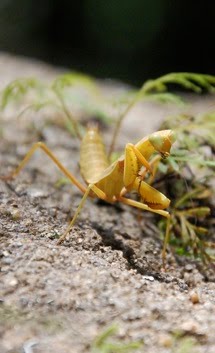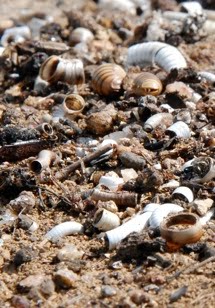It's True, a Picture of a Dead Fly on a Flower is Worth a Thousand Words

Or maybe slightly less than a thousand words, but this picture does have a lot to say. For one thing, look at the cool animal on the flower.
How many legs?
Six.
How many body parts?
Three.
Is its mouth shoved smack into some delicious nectar?
Sure is.
So it must be a bee, right?
Wrong.
Bees aren't the only insects that slurp up tasty energy-packed nectar. Flies do too. Some flies anyway. Other flies eat blood or, believe it or not, poop. But the one in the picture is a nectar lover. Insects eat nectar because it tastes good and it has lots of energy.
So plants make the nectar for the insects, because they love their six-legged friends so much, right? Not quite. Plants want the insects to come for the nectar, but while they are enjoying their delicious snack the insects usually get a bit of sticky pollon stuck on their furry legs and such. Look at the fly and you will see all the hairs. When the insect buzzes off to get another snack, it picks up some more pollen, but it also drops a bit of the other pollen off.
This is how plants get married and have babies. Fine, plants don't get married. But they do make babies. We just call them seeds. Their babies may not cry and pee and poo, but seeds to grow up to look just like their parents. And since plants don't walk, the only way for pollen to get from one plant to another to make the babies/seeds is with the help of some flying furry friends.
Let's see, what else can this picture tell us? Well, see how close that photo is? Try getting that close to a living buzzing fly sometime. It's not easy. But it is quite easy to get this close to a dead one. Yep, that fly is dead (I'll give you a moment to cry and send some flowers)...
...Ok, so why did it die with its mouth stuck in a flower? This picture was taken in the middle of the island of Madagascar. The island may be tropical, but that doesn't mean the whole place is nice and toasty and covered in coconut trees. The middle of the island is more than a mile above the ocean. And the higher you go up, the thinner the air gets. Air is like a blanket. A thick blanket is warm. A thin blanket is cooler. The thinner blanket means it gets cold at night. Sometimes even cold enough to snow in the tropics.
Flying insects don't like the cold. When it gets too cold, they can't fly. If they can't fly, they can't eat. If they can't eat, they can't get any energy. Without energy, their three little body parts get cold and they die.
Flies don't build hives or cozy nests like bees and wasps, they have to find a warm place each night. And a flower is great choice. Flowers are like little heaters. They make heat the same way you do. If you are cold, you do something. You run around, rub your hands together, shiver, shake, eat. Plants may look like they just sit there and stare at the sun, but they are all together quite as busy as the bees that land on them.
Even at night they keep working away. Plants don't sleep, they spend the night breathing just like you do. They puff out carbon dioxide and other gases from their leaves just like you do from your mouth. That puffing means things are moving inside of them and making them warm. Now during the day the plants were busy making food from the bright rays of the sun. At night, they sit down (so to speak) and eat all that wonderful food. That eating and digesting also makes them all warm and cozy. The chilly fly landed on the flower to get a bit of nectar and cuddle with the warm flower for the night, but it wasn't enough. The fly was just too cold or just too old and she went sleepy sleep forever.
Wow, this picture sure is talkative. It had a lot more to say than I thought. Right'o, but it's not done blabbering yet. Take a close gander at the rest of the plant. What do you see bristling here there and everywhere? Hairs. Those hairs mean a lot. The middle of Madagascar has two big seasons. A wet season with lots and lots of drizzles and drops and storms and a dry season with lots and lots of sun and heat and dust. If a plant wants to survive the dry season and drink till its little roots' content in the rainy season, it needs a way to get and keep all the water it can.
The tiny hairs act like a jacket to protect it from the cool nights and the hot days. Wait a second! How does a jacket help when it's hot? The hairs make a wet jacket by holding onto the nice damp morning dew. Then the dry air can suck up the dew from the plant's wet hairy jacket instead of the water inside of the plant. This particular plant, a pachypodium, also has a nice thick juicy stem full of water that it sips throughout the dry season.
Ok, I will tell the picture to shush up for now, so you can back to your learin' and such. Thanks for listening and please enjoy the much less talkative pictures below. They are from a wonderful trip last week to the mountains of Ibity in the central highlands. Come back Wednesday and Friday for more pics and tidbits from the trip.
Take care.

This lizard has some dandy camouflage that helps it hide from the birds and sneak up on the juicy critters that also linger on the rocks.

This we didn't have to sneak up on. After a long morning of hiking in the sun, we enjoyed a big plate of sweet boiled manioc. It's a potato-like root you won't find on many menus in the United States.









3 comments:
We think the insects you showed us are all fantastic! Most of us liked the grasshopper the most because of all the different colors.
The lizard was fascinating because of the way it blended in with the rock.
Thanks for starting our week off with a science lesson!
Mrs. Wadyka's fourth graders
Dear Mrs. Wadyka's class,
Great to hear from you. I just love comments. You are now my favorite class. (But in case anyone asks, just say I love all the classes equally.)
The grasshopper was fascinating. I wish I could have taken a good photo of it flying. Its wings are as wide as a new pencil and they a super bright rich red. I would give anything to see a swarm of them flying all at once.
The Malagasy love them too. With a little salt they find them quite tasty. At least some do.
Have a wonderful weekend and please come back and comment again soon.
wow, i really enjoyed finding your blog, & actually learning something! i also love that grasshopper...but i'd run screamming like a baby if i ever saw it in person! nice to meet you!
Post a Comment